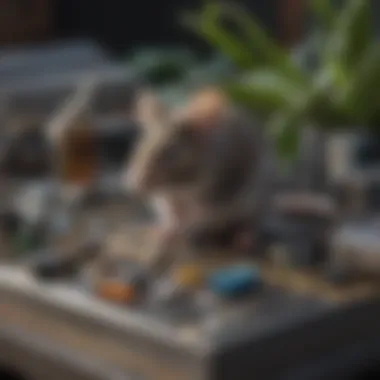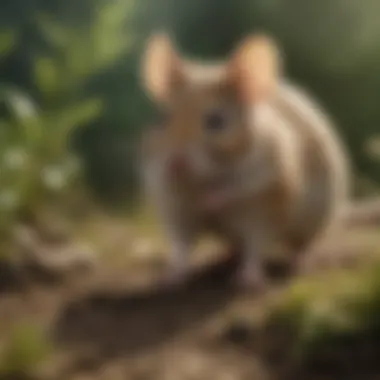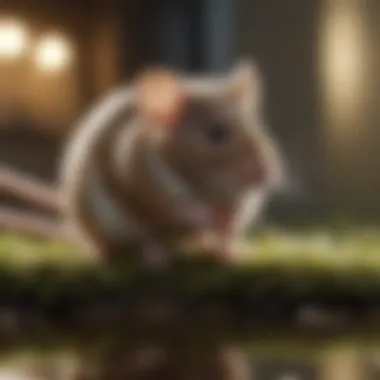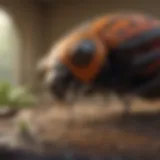Exploring Goodnature Mice: Innovative Pest Control Solutions


Preventive Pest Control Strategies
House Exterior Protection
To keep those pesky creatures at bay, start with a good inspection of your house's exterior. Here are some tips to help you seal your fortress:
- Tips for sealing cracks: Look for gaps in the foundation, around windows, and doors. Use caulk or professional foam to fill these gaps. A small crack can lead to big problems!
- Clearing debris: Keep the area around your home clear of piles of leaves and other debris. These can provide perfect hiding places for pests.
- Preventing pests from entering: Ensure your screens are intact and check that vents are properly covered. Don’t let your home be an open invitation to pests.
Yard Maintenance
Your yard can be a haven for pests if you let it go wild. Regular maintenance is essential:
- Essential yard care routines: Mow your lawn regularly and trim those bushes. Pests thrive in overgrown areas, so keep everything neat and tidy.
- Methods for keeping yard pest-free: Plant pest-resistant plants and use mulch wisely to help deter bugs. Consider using barriers like fencing to keep rodents out.
Indoor Cleanliness
A clean home is a happy home, especially when it comes to pest control:
- Expert cleaning tips and techniques: Clean regularly, focusing on kitchens and dining areas. Food crumbs are like a red carpet for pests!
- Maintaining a pest-resistant indoor environment: Store food in airtight containers and keep trash cans sealed. A little effort can go a long way in prevention.
Garbage Disposal
Don’t overlook waste management. It plays a major role in pest control:
- Efficient waste disposal methods: Dispose of kitchen waste promptly. Composting can be great, but ensure it’s managed correctly, or it can attract pests.
- Importance of proper garbage disposal: Regularly clean the bins to deter rodents and insects. A dirty trash bin can spell disaster for your pest control efforts.
Other Pest Prevention Strategies
Getting creative can help protect your home:
- Innovative ways to safeguard your home: Think about installing motion-activated lighting or using plants like lavender and peppermint that deter pests naturally. These simple, yet effective strategies can keep your home less inviting for unwanted guests.
Identifying Pest Risk Areas
Identifying where pests might enter your living spaces is crucial to effective prevention. Here’s how to stay alert:
Moisture Prone Areas Inspection
Pests love moisture. Check these areas out:
- Identifying damp conditions: Look under sinks and behind appliances for wet spots.
- Tips for preventing infestations: Use dehumidifiers and repair leaks promptly to keep those moisture-loving pests away.
Crack and Crevice Inspection Guide
These tiny spaces can lead to big problems:
- Importance of inspecting access points: Use a flashlight to check the outsides and insides of your home for possible entry points.
- Strategies for sealing cracks and crevices: Caulk can be a simple yet effective solution for sealing gaps.
Greenery Inspection for Pest Risks
Your garden can attract unwanted guests:
- Understanding greenery's impact on pests: Introduce beneficial insects to help control populations.
- Guidelines to maintain pest-free yards: Regularly inspect plants for pest signs and remove any infested plants.
Additional Pest Risk Areas
- Miscellaneous pest risk areas and preventive measures: Don’t forget to walk your property boundaries and pay heed to any potential entry points with afavorite hiding spots such as wood piles or cluttered sheds.
Effective Pest Control Methods
When prevention doesn’t cut it, it’s time to take action with effective pest control:
Natural Repellents for Pest Control
- Safe and effective natural solutions: Consider using essential oils like peppermint or eucalyptus, which can act as natural deterrents.
- Use of essential oils, herbs, and plants: Growing plants that repel pests can naturally enhance your environment, making it harder for them to settle in.
Chemical Sprays for Pest Control
When natural options fail, sometimes a chemical approach is necessary:
- Safe usage of professional sprays: Always read labels carefully and use properly to maintain safety for your family and pets.
- Eradicating pests with chemical solutions: Target specific pest issues to avoid over spraying in your space.
Pest Traps: Effective Pest Control Solutions
- Setting up and using pest traps: Keep traps in strategic locations where pest activity is suspected.
- Capturing and removing pests safely: Ensure proper disposal of trapped pests to prevent any unhygienic situations.
Biological Control Methods for Pest Prevention
- Using natural predators for pest management: Utilize beneficial insects like ladybugs to control unwanted bugs.
- Environmental-friendly pest control techniques: Implement methods that respect the ecosystem while keeping your area pest-free.
Other Pest Control Methods


Look beyond normal pest control methods:
- Innovative pest control methods beyond traditional options: Research biological treatments that might offer modern solutions to pest problems without harsh chemicals.
Pest Species Identification
Understanding what you’re dealing with is half the battle:
Common Insects in Home Pest Control
- Recognizing and managing insect infestations: Look out for signs like droppings and nests.
- Types of insects like ants, cockroaches, and spiders: Know the characteristics of common household pests for quicker action.
Identifying Rodents for Pest Prevention
Mice and rats are notorious:
- Tips for identifying and preventing rodent invasions: Look for droppings or gnaw marks as a clear invitation to their presence.
- Types of rodents including mice and rats: Understanding their behavior can aid in prevention efforts.
Bird Species Impacting Home Environments
- Addressing bird-related issues around the home: Certain bird species can create nests and become nuisances.
- Troublesome bird species in residential areas: Be aware of species like pigeons or starlings that might flock to your property.
Dealing with Wildlife on Your Property
Managing larger pests:
- Handling wildlife encounters effectively: Research local wildlife and understand humane ways to manage their presence.
- Behavior and control measures for wildlife species: Implement barriers and fencing to deter larger animals from entering your home or garden.
Miscellaneous Pest Species Identification
There are hidden pests too:
- Managing lesser-known pests effectively: Awareness of less-common pests can help you stay ahead of infestations.
DIY Pest Control Techniques
Sometimes, the best solutions are those that you craft yourself:
Homemade Pest Control Solutions
- Eco-friendly homemade pest control remedies: Create a simple vinegar mixture to ward off ants and other bugs with ease.
- Protection against pests using simple DIY methods: Salt can also repel slugs and snails. Many household items can serve as effective deterrents.
Using Essential Oils for Pest Control
- Repelling pests naturally with essential oils: Mix oils with water and spray around entry points for a fragrant way to keep pests at bay.
- Creating a bug-free environment at home: Changing the scent can sometimes help in keeping your home less attracting.
Effective Pest Traps and Barriers
- Setting up traps and barriers for pest control: Homemade and store-bought traps can work side by side effectively.
- Controlling and preventing pest infestations: Always stay alert to new pest signs to nip any situation in the bud.
Top Reputable Pest Control Brands
- Products for home pest management from trusted brands: Research top brands for products that align with your values and needs.
- Safeguarding your home with effective solutions: Using reliable brands can lead to a more confident approach to pest management.
Miscellaneous DIY Pest Control Techniques
- Unique solutions for various pest issues at home: A little creativity can lead to effective pest management without heavy costs. Even simple measures can make a difference in preserving your haven.
Understanding the Goodnature Mouse
The Goodnature mouse traps have garnered significant attention recently, particularly for those seeking ethical solutions to a pesky problem. Understanding this innovative device is crucial, giving insight into not only how it functions but also its larger implications on our households and environments.
Definition and Purpose
At its core, the Goodnature mouse is designed to provide a humane and efficient method for controlling rodent populations. Unlike traditional traps that typically rely on lethal force, Goodnature traps focus on humane extermination, facilitating a quick and painless process. The main purpose isn’t just to eliminate mice, but to promote a sustainable approach to pest control.
Moreover, these devices are engineered to operate automatically, often needing minimal human intervention after initial setup. This feature appeals to homeowners who prefer minimal maintenance yet desire effective results. Having one of these traps around can give housewives and property owners a sense of security, knowing they are not only protecting their homes but also taking a stance towards responsible pest management.
Historical Context
The journey of the Goodnature mouse dates back to evolving pest control strategies that aim to strike a balance between efficiency and ethics. Historically, rodent control methods have been largely ruthless; this stark reality demanded a shift in how we approach those tiny invaders. In the past, methods such as poison and snap traps contributed not only to the death of the target species but also inadvertently impacted predator species and the local ecosystem. Groups of environmentally conscious people and researchers began advocating for changes in how we handle rodent populations to ensure a more balanced coexistence with wildlife.
The Goodnature mouse was conceived amidst this rising awareness. Innovators noticed a market gap for humane alternatives that delivered on efficiency without compromising ethical standards. In recent years, the device has become both a symbol of progress in eco-friendly practices and a practical tool for those managing mouse infestations in homes.
Today, as discussions about sustainability and wildlife conservation flourish, understanding the Goodnature mouse's background allows consumers to feel informed and empowered in their choices. With insights into its purpose and historical development, you can appreciate the nuances of this device's role in modern pest control.
Main takeaway: Goodnature mouse traps represent not just a solution but a responsible attitude towards nature and pest management.
The Technology Behind Goodnature Mice
Understanding the technology that powers Goodnature mice is essential for grasping their role in modern pest management. These devices utilize innovative mechanisms and design features tailored for effectiveness and user-friendliness. The robust engineering behind Goodnature mice stands out as a transformative force in the pest control industry.


Mechanisms of Action
Detection Sensitivity
The detection sensitivity of Goodnature mice is a pivotal aspect that enhances their effectiveness. This feature enables the devices to identify pest presence accurately and swiftly, ensuring timely intervention. Goodnature mice are built with sensitivity that can distinguish between various rodents, allowing them to react to specific triggers without being misled by random movements.
One key characteristic here is the precision of the sensors. This high sensitivity minimizes the chances of false alarms or missed opportunities to catch pests. The sensory technology employed is considered a favorable choice among eco-conscious homeowners aiming for targeted pest control. A unique aspect of this sensitivity is its adaptability; it can recognize environmental changes, adjusting its operations accordingly. However, this may require regular calibration, presenting a minor challenge for some users.
Trigger Systems
Trigger systems in Goodnature mice are designed to ensure a swift, humane response to the captured rodents. They function like a finely tuned clock, releasing a mechanism that effectively neutralizes the pest while minimizing distress. This timely action is essential in meeting both ethical standards and practical effectiveness.
The standout feature of these systems is their reliability; they rarely malfunction, providing peace of mind to users. This reliability is what makes Goodnature a popular choice in humane pest control solutions. A unique benefit of their trigger mechanism is the ability to reset after each capture, eliminating the need for constant manual intervention. However, one disadvantage could be the learning curve for some users who may find the initial setup a bit complex.
Design Features
Materials Used
The materials used in the construction of Goodnature mice play a significant role in their durability and efficacy. These devices are crafted from high-quality, weather-resistant materials that can withstand indoor and outdoor environments. This durability allows Goodnature mice to perform effectively even in harsh conditions, which is crucial for homeowners dealing with potential infestations.
An essential characteristic of the materials chosen is their sustainability. Goodnature has made efforts to use recycled components where possible. This eco-friendly focus not only resonates with consumers but also aligns with wider environmental initiatives. One unique aspect of these materials is their ease of cleaning, making upkeep simpler for users. On the flip side, while these materials offer robust performance, their initial cost can be a bit steeper compared to traditional traps, possibly deterring some buyers.
User Interface
The user interface of Goodnature mice is thoughtfully designed to ensure an effortless experience from setup to maintenance. This is vital because a friendly interface helps both seasoned pest control users and novices engage with the product effectively. Key features include clear indicators for setup instructions, system alerts, and maintenance checks.
A strong aspect of this interface is its intuitive layout, which makes navigating the settings a breeze. This is particularly precious for homeowners who may not be tech-savvy. The unique feature of the interface is its real-time monitoring capacity, which informs users of activity and ensures they are always in the loop. However, a disadvantage could be the occasional software glitches, which might require technical support attention.
Effectiveness of Goodnature Mice
Understanding the effectiveness of Goodnature mice is crucial for grasping its role in pest management. This section aims to shed light on how these devices stack up against traditional controls and other humane options available today. Recognizing the benefits and considerations can further empower homeowners and housewives seeking practical yet ethical solutions to their rodent problems.
Comparative Analysis
Traditional Rodent Control
Traditional rodent control methods have long been the backbone of pest management. They typically include traps and poison, which are highly effective in swiftly reducing rodent populations. However, these methods often come with significant downsides. The key characteristic of traditional rodent traps is their instant outcome, effectively eliminating the pest on the spot. This efficiency makes them a go-to choice for many homeowners.
Yet, these methods can introduce risks. For instance, using poisons raises concerns around non-target species, including pets and children. In fact, many accounts exist of household pets suffering adverse effects due to accidental consumption of rodenticide. When examining their effectiveness, one must weigh the immediate gratification of traditional methods against the broader consequences they might bring to household dynamics.
- Advantages of Traditional Rodent Control:
- Disadvantages:
- Instant elimination of pests
- High accessibility and low cost
- Risks to non-target species
- Potential long-term ecological harm
Other Humane Options
In contrast, other humane options strive for a more compassionate approach to pest control. These may include catch-and-release traps or natural deterrents, emphasizing non-lethal methods to handle rodent issues. The beauty of this humane route is its alignment with growing consumer demand for ethical choices in pest management. The overall objective of humane options is to manage rodent populations without unnecessary harm. One unique feature of humane traps involves their ability to safely capture rodents alive. This characteristic allows for relocation, minimizing the ecological footprint of pest control.
- Advantages of Other Humane Options:
- Disadvantages:
- Ethical treatment of animals
- Reduction of long-term ecological impact
- Often requires more time and effort for effective control
- Some methods might not be as immediately effective as lethal options
Field Studies and Results
Urban Settings
The dynamics of urban settings present unique challenges and opportunities in rodent management. The density of human habitation, combined with abundant food sources, can create ideal conditions for rodent infestation. Goodnature mice have shown promise within these environments, capturing the attention of urban homeowners. One of the key benefits of employing Goodnature mice in urban settings is their ability to efficiently reduce rodent populations without relying on toxins. Field studies indicate a significant reduction in rodent sightings and damage to property when these devices are integrated into rodent management strategies.
- Unique Features in Urban Settings:
- Non-toxic mechanisms prevent risks to pets and children
- Encourages responsible pest management practices
Agricultural Impact
Agricultural environments can be quite different from urban settings, presenting unique pest control needs. The impact of rodents on crops can be devastating, yet many traditional deterrents pose risks to livestock and the ecosystem. Goodnature mice in agricultural impacts showcase a model of effective pest control that aligns with sustainable practices. Farmers have reported increased yield and less crop damage since utilizing these humane devices, sparking a growing interest in integrating Goodnature mice into farming techniques.
- Unique Features in Agricultural Settings:
- Compatibility with organic farming principles
- Long-term ecological balance achieved through humane practices
"Goodnature mice exemplify a shift towards sustainable and ethical rodent control, offering viable solutions for both urban homeowners and agricultural practitioners."
As the understanding of Goodnature mice continues to evolve, its effectiveness stands out amongst alternative rodent control methods, offering a refreshing perspective on pest management.
Ecological Considerations
The Goodnature mouse isn't just a tool for pest control; its influence ripples through local ecosystems and agricultural practices, bringing about significant ecological considerations. This section delves into the intricate relationship Goodnature mice share with nature, focusing on how their design fosters harmony rather than disruption in our ecosystems.
Impact on Local Ecosystems


Non-Target Species
When discussing non-target species, it's vital to highlight that these are organisms which don't fall prey to the Goodnature traps yet are prevalent in the same ecosystems. These species often play an essential role in maintaining the ecological balance. For instance, while attempting to control rodent populations, traditional methods might inadvertently harm beneficial creatures such as birds or small mammals. In contrast, Goodnature mice are engineered to minimize such risks. The traps use specific attractants that target unwanted rodents without adversely affecting non-target species.
The key characteristic here is the humane aspect of pest control, ensuring that other wildlife can thrive. This thoughtful design illustrates a harmonious balance, safeguarding the biodiversity present in many ecosystems. Nevertheless, one must also consider the potential disadvantages; if not used correctly, even the best-designed traps can alter local wildlife interactions, which in turn can influence food webs.
Biodiversity
Now, let’s dive into biodiversity. The preservation of diverse species is critical for ecosystem health. A rich variety of species contributes to resilience against diseases, pests, and environmental changes. When utilizing Goodnature mice for pest control, there lies a huge advantage in promoting a healthier biodiversity. By fostering a non-toxic approach to rodent control, lands become more inviting to various plants and animals.
Moreover, biodiversity is integral to stable ecosystems. A more species-rich environment ensures that resources are used efficiently and ecosystem functions remain intact. However, it’s pivotal to remain aware of how pest control devices can unintentionally disrupt these systems if they skew populations in one direction. An example would be an abundance of certain non-target species that could emerge if rodents were over-controlled.
Sustainable Practices
Integration with Organic Farming
Integration with organic farming is another crucial aspect when we think about Goodnature mice. Using these humane traps aligns perfectly with organic practices, which eschew harmful pesticides and toxic chemicals. Farmers who adopt Goodnature traps report improved pest management without compromising their commitment to environmental sustainability. Organic farming thrives on the idea of nurturing the soil and surrounding ecosystems, and the incorporation of devices like Goodnature mice fits right into that philosophy.
The unique feature here is how organic farmers can manage rodent populations without risking their organic status while also benefitting from healthier soil conditions. However, one drawback could be the initial investment in such traps compared to more traditional methods, leading to hesitation among some farmers.
Long-Term Solutions
Lastly, let’s take a look at long-term solutions. The demand for persistent and effective pest control has led to a greater emphasis on finding methods that ensure sustainable results over time. The Goodnature mouse is designed for longevity, minimizing the frequency of replacements while effectively managing rodent issues. This approach contributes to less waste and promotes a cycle of responsibility, which is a welcome change in today’s consumer culture that often leans towards disposable products.
The significant advantage of these long-term solutions is their potential contribution to sustainable living practices. Over time, the reduction in rodent populations can lead to healthier crops and ecosystems, fostering a more natural balance without resorting to chemical solutions. Yet, it’s essential to remain vigilant; if the traps are not maintained properly or used inappropriately, they might lead to a resurgence of pest problems instead.
In summary, the Goodnature mice not only provide a humane solution for pest control but also open the door to broader ecological benefits that can help maintain the delicate balance of our natural surroundings.
Implementing these traps positions their users as stewards of the environment, emphasizing responsibility and care in pest management while contributing positively to local ecosystems.
Consumer Perspectives
The views and experiences of consumers play a pivotal role in understanding the Goodnature mouse and its adoption in various settings. As this pest control device aims to address environmental and humane concerns, consumers’ perspectives reveal the nuances of how this product aligns with their values and practical needs. Delving into consumer feedback not only highlights the strengths and weaknesses of Goodnature mice but also enriches our insight into emerging trends in pest management.
Market Trends
Growth of Humane Products
The surge in humane pest control products such as the Goodnature mouse reflects a broader societal shift toward ethical product consumption. This trend has cropped up as more individuals are willing to invest in solutions that do not compromise animal welfare. Key characteristics of this growth include increased consumer awareness regarding the impact of traditional pest control methods, which often lead to needless suffering of animals.
Such awareness has fueled a rising demand for humane products, allowing consumers to make choices that resonate with their ethical beliefs.
- Unique Feature:
Many humane products, including Goodnature mice, are designed to minimize suffering while effectively addressing rodent problems. The advantages here are clear: they not only neutralize the immediate pest issue but also reduce the collateral damage to non-target species. - Benefits & Disadvantages:
While these humane solutions come with the benefit of ethical responsibility, they may initially have a higher cost compared to traditional traps. However, this upfront investment often pays off in consumer satisfaction and peace of mind.
Consumer Demand Analysis
The analysis of consumer demand is fundamental in understanding how products like the Goodnature mouse fit into the pest management landscape. As families and individuals become increasingly eco-conscious, demand for humane solutions rises. Characteristics of this demand indicate a preference for products that harmonize technology and nature without causing harm.
- Unique Feature:
Comprehensive market studies reveal that consumers prioritize the effectiveness of pest control methods while also looking for those that align with sustainable practices. This dual focus on reliability and ethics presents a noteworthy dynamic. - Benefits & Disadvantages:
While this demand has significantly contributed to the popularity of humane options, it can also create challenges for companies that need to balance cost, efficiency, and sustainability in their offerings.
User Reviews and Experiences
Functionality Feedback
Gleaning insights from user reviews illustrates the direct benefits of Goodnature mice in action. The functionality of these devices resonates with consumers, particularly regarding their ease of use and effectiveness. A hallmark of this feedback is the device's innovative design that allows for straightforward setup and minimal maintenance.
- Key Characteristic:
Many users claim that the Goodnature mouse operates quietly and efficiently, reducing the hassle often associated with traditional traps. - Unique Feature:
An aspect that often stands out in reviews is the self-resetting mechanism, which sets it apart from one-use traps. - Benefits & Disadvantages:
This continuous operability appeals to users who prefer a low-maintenance solution, though some reviews note a learning curve in effectively deploying the device initially.
Customer Service Insights
Customer service insights offer a window into the overall consumer experience beyond just the product itself. Feedback on the support provided by the Goodnature team indicates a strong commitment to customer satisfaction. Characteristics of effective customer service range from prompt response times to knowledgeable representatives.
- Key Characteristic:
Many users have reported positive experiences regarding the follow-up care and support offered, which further enhances trust in the brand. - Unique Feature:
Social platforms often reveal how responsive Goodnature is to customer queries, fostering a supportive community among users. - Benefits & Disadvantages:
While this level of customer engagement is commendable, some users have shared discrepancies in response times during peak seasons, highlighting the need for companies to scale support resources appropriately.
In summary, understanding the consumer perspectives on Goodnature mice illustrates a growing preference for humane pest control solutions. It showcases how market trends and user experiences converge to shape the future of pest management while underscoring the importance of addressing both effectiveness and ethical considerations.
Future Directions
Understanding the future directions of Goodnature mice emphasizes the significance of advancing human-animal coexistence strategies in pest management. This exploration isn't just about improving current methods but also about forging pathways that blend technology, ethics, and legislative frameworks to create more effective pest control solutions. These insights shine a light on where we might head next, particularly for house owners and those keen on humane solutions.
Technological Innovations
Smart Technology Integration
The integration of smart technology into Goodnature mice represents a major shift in how we approach pest control. With features such as remote monitoring and smartphone connectivity, these devices have taken convenience to a new level. Homeowners can receive alerts directly to their phones when an action has been triggered or when maintenance is due. This real-time capability means less guesswork and more timely interventions.
One of the standout characteristics of this innovation is the ability to analyze data trends. This could be particularly beneficial as it allows users to understand peak activity times for rodents, thus optimizing their pest control strategies. However, a notable challenge is ensuring user privacy and secure handling of data. Technology is great, but it can be cumbersome if not integrated with a robust privacy framework.
Potential for AI Applications
The application of artificial intelligence in pest management has the potential to revolutionize this field. AI can analyze vast datasets to predict rodent behavior, ensuring a proactive rather than reactive approach. A key characteristic of AI applications is their adaptability, which can learn from the environment and user interactions to improve effectiveness over time. If successfully implemented, this could save homeowners time, effort, and resources.
Nevertheless, as with any emerging technology, there are advantages and disadvantages. The unique feature of AI applications lies in their ability to process real-time data, significantly increasing the efficiency of pest control measures. However, some may be concerned about the reliability of AI systems in unpredictable situations. It's crucial to balance technology with traditional methods’ intuitive understanding of pest behavior.
Legislative Implications
Regulatory Considerations
As the movement towards humane pest control grows, regulatory considerations play a pivotal role in its evolution. Understanding the implications of existing laws and potential changes is essential for manufacturers and users of Goodnature mice. Keeping abreast of regulatory developments ensures that these methods meet legal requirements while still providing effective pest management strategies for households.
A vital characteristic here is the growing emphasis on sustainability and eco-friendliness in regulations. New policies may promote products that minimize harm to non-target species while ensuring rodent population management. However, navigating this landscape requires attentiveness to varying regional regulations, as these can be vastly different. A consistency in regulatory frameworks would simplify compliance for manufacturers and provide clearer guidelines for users.
Ethical Standards for Pest Control
Setting ethical standards for pest control is no longer optional; it is a necessity in modern pest management discourse. As more consumers gravitate towards humane solutions, ethical considerations increasingly shape public policy and consumer preferences. This evolution impacts how companies like Goodnature develop their products.
One key feature is the principle of "integrated pest management"; this approach combines various strategies to ensure humane treatment of pests while effectively managing their populations. A commitment to ethical standards helps build trust with consumers who are increasingly concerned about animal welfare. However, there’s always the risk of ethical standards being viewed as a marketing gimmick rather than genuine. Balancing profit motives with ethical imperatives remains a challenge the industry must face.



